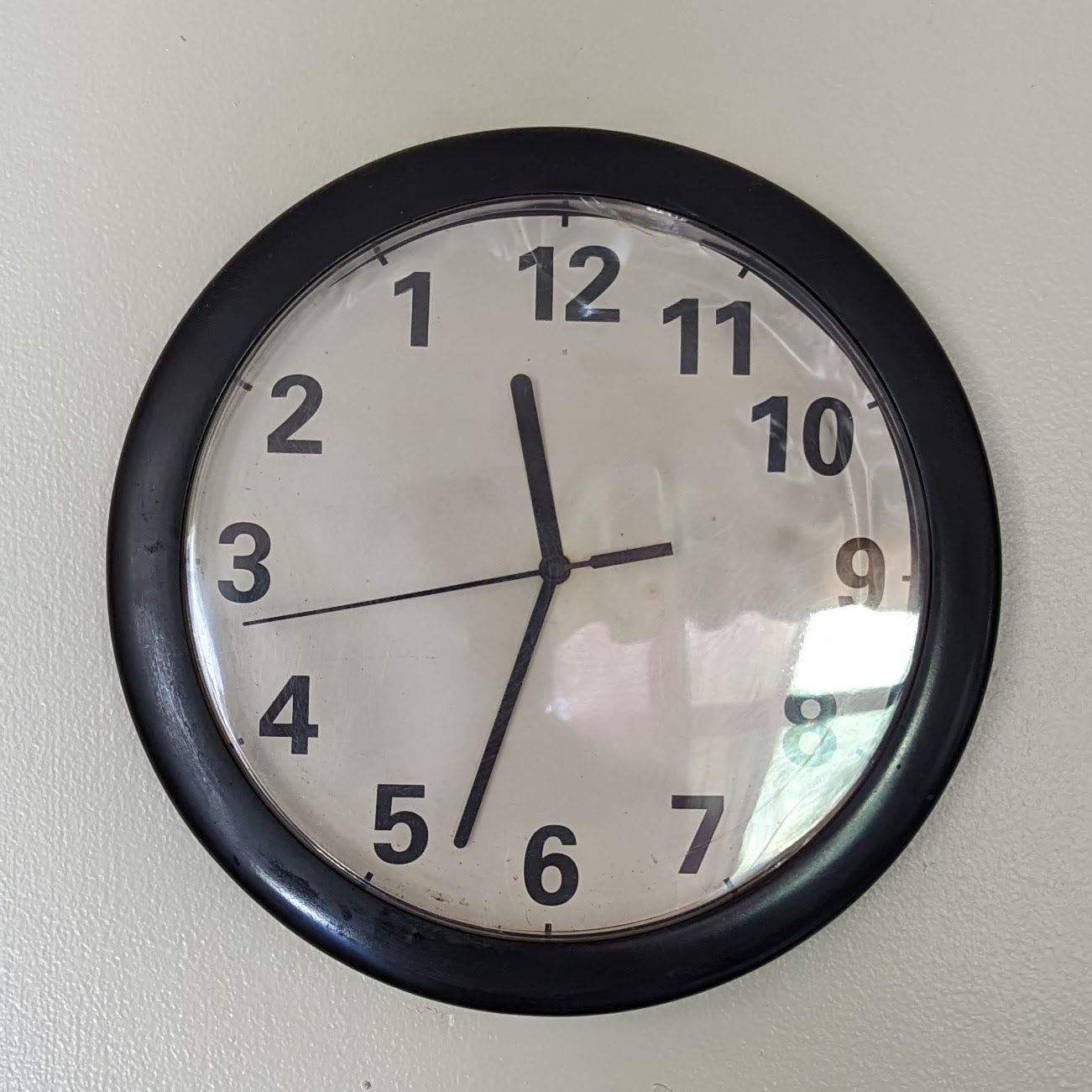Was there an alternative adjective to “clockwise” other than “the rotation you take around left hand”?
Also, how did all watch companies around the world agree on what the direction of “clockwise” is?
This turned out to be a surprisingly fascinating question lol.
Imagine you’re in the Northern Hemisphere and you face east toward the rising sun. Over the course of the day, the sun will seem to move to the south, and then set in the west. This forms a “sunwise” turn, which is what we now call “clockwise” because we made clocks in imitation of sundials.
In Swedish it’s called medsols and motsols. The iteral translation is with the sun and against the sun.
Is there a large perceptible pronunciation difference? Because if not med and mot being opposites seems like it’s rife for sitcom hijinks
There is, yeah, /meːd/ and /muːt/
Thank you! That makes sense, I forgot north Germanic languages don’t do final devoicing. In German, the d would be pronounced as /t/ in that position.
You rarely hear voiced plosives in spoken German in general. Negative VOTs are virtually unheard of. The distinction would be more accurate if described as aspirated/unaspirated than unvoiced/voiced.
I guess what I wanna say is that German 'd’s are most likely gonna be realized as /t/, no matter where they occur in the utterance.
Turnwise and widdershins
GNU Terry Pratchett
I always heard it as ‘deosil and widdershins’
Ironically, I believe ‘turnwise’ is the one that’s made up – by Terry Pratchett.
As a non-native English reader, I now am not sure if this is a Pratchett reference or if these are actual round world terms…
Pratchett’s just using real-world (albeit archaic) terms: widdershins and deosil.
Good question!
The real answer seems to be “right” and “left”.
Up and down?
In czech, we have a phrase “jak sa kráje chleba” (same way as a bread is sliced). Problem is, that (at least in my social group) nobody knows, wether it means clockwise or anticlockwise, as everybody slices the bread differently.
same way as a bread is sliced
Haha interesting, but how do you slice bread by rotation? it’s up to down. That’s how you cut stuff.
- Grip the bread vertically to your chest.
- Start cutting in direction from the front to the back.
- Slowly rotate the bread, so you cut the crust only in one point (the tip of the knive moves through already cut bread).
It may be easier to see it with a short knive.
Well, clocks are just mechanical sundials. Before clockwise, there was sunwise (or deosil), and clocks’ movements are based off of the movement of a shadow across a sundial.
Used to be sunwise and counter-sunwise.
Ok, but how about before the sun?
Galaxywise and counter-galaxywise
and the rival; pixelwise and counter-pixelwize
does that mean that “clockwise” in the southern hemisphere is backwards?
No, because the earth is still rotating the same direction in the southern hemisphere
I read this article and I’m more confused now lol
https://en.wikipedia.org/wiki/Sundial#In_the_Southern_HemisphereEDIT: The last sentience sums it up well tho:
On horizontal northern-hemisphere sundials, and on vertical southern-hemisphere ones, the hour marks run clockwise.
Well well, learn something new everyday.
Pretty weird to think about. And about them having to either face their relevant poles or the equator for them to work equivalently
Northern sundials (both vertically mounted and horizontal versions) need to be pointed North, whereas Southern sundials need to be pointed South. The article is stating that Southern horizontal versions can be mounted vertically in the Nothern hemisphere but must be pointed South. I hope that helps, I had to re-read it a few times, myself.
Yes, when you are in the northern hemisphere, a sundial shadow falls to the north of the gnomon (the thing that makes a shadow). This makes the shadow move from the northwest to north to northeast over a day, which is clockwise. In the southern hemisphere, the shadow from the gnomon falls to the south, so it starts in the southwest and moves to the south and then southeast, which is anticlockwise.
The most obvious way to see this is the photo of the sundial in Perth, where the hours run anticlockwise.
https://twitter.com/culturaltutor/status/1605415745093083137?lang=en https://en.wikipedia.org/wiki/Sundial#In_the_Southern_Hemisphere https://en.wikipedia.org/wiki/Sundial#/media/File:Sundial_in_Supreme_Court_Gardens,_Perth.jpg
Yes, because of the Coriolis effect (/j)
It’s just negative rotation
Yes, but it’s learning optimism.
deleted by creator
Deosil, which is the direction the shadow on a sundual moves (in the Northern Hemisphere).
A guy I know owns this clock, which basically proves that everything in life is pointless and arbitrary:

I have one of these, it was a gag gift from a friend. I’ve had it up so long now though I have to double check which clock in looking at before I tell the time because I’ve got so used to it
That’s pretty cool. Also, your username contains an anagram of the name of the man who owns the clock from my comment. That’s also pretty cool.
Oh, you mean like the order of the Alphabet?
That’s actually the only non-arbitrary thing in existence. If the alphabet wasn’t in alphabetical order, we’d all be dead right now.
This is correct. Alphabetical Order is one of the fundamental laws of nature. A universal constant.
I like how I was joking but we still ratio’d that guy.
Alphabetic order is completely facist nonsense. Obviously the n should come before the m. You wouldnt put w before u, would you?
#wakeupsheeple
I might be evil because now I want a clock like that only with the 1 starting where the 4 is.
It wouldn’t be that hard. Once you get a clock like this with the reverse movement, you can just open the face glass, remove the hands, and print a new graphic for the background.
deleted by creator
I don’t think you’re evil, but there is definitely something wrong with you. lol
Weird, this feels easier to read. Less grating somehow.
You left-handed?
Nope. Right handed. But AuDHD like there’s no tomorrow…
You just flipped the image!
(/s)
Also why the seemingly arbitrary graduations, 24 hours, 60 minutes, 60 seconds. If it was say 10 hours in a day, 100 minutes in an hour, 100 seconds in a minute, seconds would be close to the same amount of time. Same with latitude and longitude, why 360 degrees in a circle with 60 minutes in a degree and 60 seconds in a minute.
It’s all based on 12, which is nice cause it’s divisible by 2, 3, 4 and 6.
A system based on 10 gives you issues if you want to divide the year into 4 seasons, the day into morning, midday, evening and night, the compass into cardinal directions, etc…Morning, midday, evening and night are arbitrary. Why not just morning and night? Why not morning, mid-midday, midday, evening, mid-evening, and night?
The number of seasons is likewise arbitrary. Some Native American tribes had more than 4 seasons.
The short explanation is that those numbers are more easily divided by a larger set of denominators. 24 is divisible by 2, 3, 4, 6, 8, and 12. 100 is divisble by 2, 5, 10, 25, and 50. 60 is divisible by 2, 3, 4, 5, 6, 8, 10, 12, 15, 20, and 30.
Metric is great for scaling up and down ad infinitum, but it sucks for fractions. Fractions are easier for daily use without precision measuring equipment.
The units of time we use come from a bronze age civilisation that used base twelve instead of base ten. They’d count on their hands using the finger joints of one for single digits, and then the joints of the other for multiples.
Other commenters hit on the reasoning, just adding that they’re called highly composite numbers. My favorite!
These numbers aren’t arbitrary, they are from different base numbering systems.
60 can easily divide by 2, 3, 4, 5, 6, and 10.
12 can easily divide by 2, 3, 4, and 6 (notice how much overlap there is).
10 only divides easily by 2 and 5. Common fractions like 1/4 or 1/3 now require decimals.
Basically, base 12 and base 60 make it significantly easier to think and work in common fractions.
It is also historically significant, as base 12 used to be more common than modern base 10. Our timekeeping system dates back to the ancient Babylonians, who worked in base 12. This influence is still felt in other places, such as the fact that eleven and twelve have unique names in many languages rather than following the same pattern as everything that comes after them.
That’s called Decimal time and revolutionary France already tried it.
It is a non-existing problem, because they were talking in other languages then.
As someone who still confuses these “turn it around that way” - jiggles hand in vague motion- “oops no the other way” usually works just fine.
Turnwise and widdershins. I read it in a book once.
Sunwise, as it was based on the movement of the sun during day (in the Northern hemisphere). As watch faces were modelled after sundials, sunwise and clockwise describe the same direction.
Turnwise is a word invented by Pratchett for a book, but it’s clearly based on sunwise. He also used widdershins in his book, which is indeed the unmodified antonym to sunwise.
Not just any book. The discworld series. It’s the direction the disc rotates! He has so many easy to miss spots of genius. Amongst many easy to see spots of genius
Does the sun rotate with the disc, and faster?
Wouldn’t sunwise and turnwise be in opposite directions otherwise?
The sun rotates around the disc too one of the elephants has to cock its leg every day
Deosil (sunwise) was the opposite of widdershins (against the usual). Both had a wide range of uses too, not just directionality.
I have found my people.
Was it Name of the Wind or Wise Man’s Fear? I just read both of those and I remember looking up one of the words and going down a Wikipedia rabbit hole.
No, those words don’t appear in those books. He’s referring to Discworld by Terry Pratchett.
Well shit… those are the only two books that I read recently, maybe a similar word… I left my kindle at home today I know that keeps track of words I’ve looked up and now I’m curious
I have the feeling that the direction of the water in the toilet when flushing plays an important role here.
The first mechanical clocks were invented around 1300. The first flushing toilet was 1775.
“we don’t have clocks, how do we describe right ways or leftways rotation?”
“Well, the tires on my Dodge Ram 3500 rotate to the right when I drive it forward, so we’ll call it ramforward and rambackwards”
“Brilliant”
Yup. That’s definitely “down”.
Ah yes, turdwise and widdershits as it was known in the olden days, before the invention of sundials
I don’t have an answer for the original question, but what about just saying rotate right/left?
I mean, if I imagine a circle rolling on a flat surface, rotating right means the rotation that rolls the circle right (so clockwise rotation), and rotating left would be the opposite; where the circle rolls left.
Seit das Deutsche Reich besteht, wird die Schraube nach rechts gedreht!
Rotating right/left as measured from the top or the bottom changes the rotation.
What if the wheel is fixed to a frame and it moves a sheet above it like a conveyor system? Is the frame of reference the direction the sheet moves or is it how the wheel moves against the sheet? What if the sheet is below it like a pasta machine or sheet metal former? That being said, “right tightly, lefty loosey” has certainly prevailed
It works, but it’s ambiguous. You have to specify which part you’re referring to if you want to be sure you’re understood.
You have to specify which part you’re referring to
What do you mean by that?
No matter which direction a ball rolls, part of it moves to the right, and part to the left (either top right and bottom left, or vice versa). If you don’t specify which part of the ball you’re looking at, it could be either top or bottom, so the statement is ambiguous.
but without this information, clockwise and anticlockwise also ambigous.
No, they are well-defined. There is no missing information in “clockwise”. There is missing information in “right”.
There is no “top clockwise” or “bottom clockwise”.
Turning right, looking at the top of the clock, is different from turning right while looking at the bottom of the clock. And so on.
You’re not entirely wrong, but the convention is to refer to the top of the wheel. But you could be looking at the wheel from the other side, which would change its direction from your perspective.
That’s true, but saying clockwise/anticlockwise also works with fixed perspective, unless the thing itself has a fixed orientation. but if that’s the case, left/right works the same.
No, it’s an extra level of confusion. Clockwise/counterclockwise only has one axis of confusion (looking from front or behind) with one option being the obvious default. Left/right have this axis AND the axis of top/bottom for confusion. It’s literally one bit more ambiguous.
Honestly the hardest concept for me to grasp in organic chemistry was left vs right chirality. I could understand why they were different, but fuck me if i could ever consistently identify them.

















